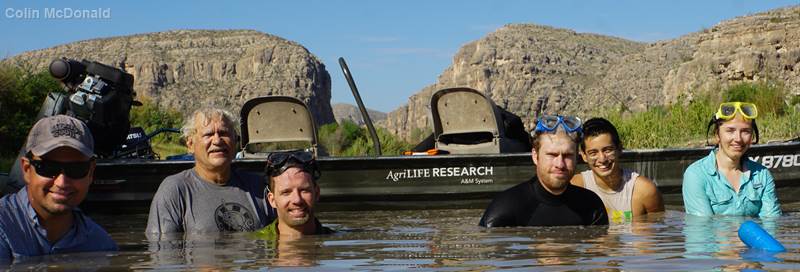Dr. Charles Randklev is not one to shy away from challenges. In fact, based on his current field of research, he seems to embrace them.
As the principal investigator for Texas A&M Institute of Renewable Natural Resources Texas A&M University Mussel Research Group, exploring freshwater mussel populations literally involves getting his feet wet — sometimes wading waist deep in Texas streams and rivers.
Randklev became interested in mussel conservation during his undergraduate time at the University of Texas – Arlington, where he volunteered in a research lab in the Department of Biology. At the time, most research on freshwater mussels focused on invasive species; little was known about the status and distribution of native unionid freshwater mussels. The allure of an unexplored field and the overall decline of unionid mussels in the United States is what prompted Randklev to pursue a research program focused on conserving native mussel populations in Texas.
“The focus of our group is to help conserve rare and common mussel species and to do this requires understanding the status and distribution of the species and how that compares historically,” he said.
Since 2011, his research has led him across Texas, often in rivers that were presumed to be uninhabited by mussels. This approach has yielded successful results, most notably the discovery of several freshwater mussel species thought to be extinct or eradicated.

As part of their conservation efforts, the team may relocate threatened species whose habitats may be damaged by bridge construction to a different part of the river. They also conduct follow-up assessments to evaluate survival, growth and reproduction.
In addition, his research focuses on describing geographic patterns in mussel distributions within and between drainage basins and examining how environmental and man-made factors contribute to those patterns.
The team is now studying the reproductive behaviors for several threatened mussel species. Randklev said unionid mussels have an unusual reproductive process, whereby a host, usually a fish, is needed for their larvae to reach juvenile stage. Some mussel species can use a large number of fish species as hosts, while others are very specific. “In Texas, hosts are known for only 13 of the 52 mussels species, which means there is still a lot to learn, which is exciting,” he said.
Human-mediated impacts can destroy mussel and fish habitat, and this can lead to mussel population declines, which overtime will eventually effect their distribution, Randklev said. Surveying for mussels to determine their distribution and abundance, identifying habitat associations and evaluating their reproductive biology are important tools for minimizing these impacts and preserving the remaining mussel fauna in Texas.
Randklev said what he enjoys most as a research scientist is being out in the field and collaborating with other researchers and graduate students.
“I look at the field as my laboratory,” he said. “I like seeing my research put to practice.”
Randklev is also involved with public outreach where he has co-hosted several mussel workshops to help educate the public, industry and resource managers about threats, monitoring and identification of unionid mussels.

